
There are so many choices! How do you know which one to buy? It used to be so simple—you needed a 60W light bulb so you went to the store and got a 60W light bulb and screwed it into your light fixture. But LED light bulbs have changed the market—and now, there are more options than ever!
There are several factors to consider when looking at your options at the store:
All of this information can be found on the light bulb packaging if you know what to look for. Below, we'll take a look at what each of these distinctions mean.
If you are not sure which style light bulb you need—take a look at the light fixture. Nine times out of ten, there is a a sticker on the light fixture that will tell you the bulb style and the maximum wattage for the bulb.
Here is a chart of light bulb shapes and sizes (image courtesy of bulbs.com):
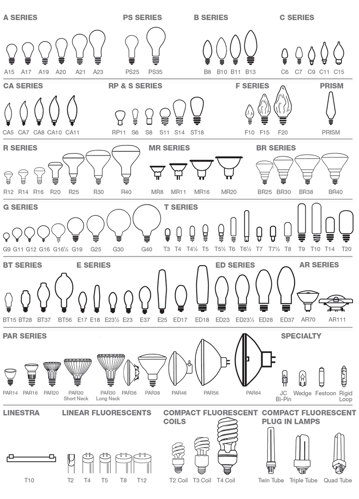
Click here to download our light bulb buying checklist
Wattage is the measure of the amount of energy used when a light bulb is on. Traditional incandescent bulbs were all categorized by their Watts or W (60W, 100W, etc.). Now that LED light bulbs use a lot less wattage, they list the wattage equivalent or replacement on the packaging.
This means the light bulb will be similar to a traditional incandescent bulb of that wattage, but the great thing about LED light bulbs is that they use a lot less energy.
In the example below, the bulb is a 100W replacement but it is only using 15.5 Watts! That means you can run six of these light bulbs all at the same time and the energy used will be a little less than the energy used if you were running one traditional 100W incandescent light bulb.
An incredible energy savings for both the planet, and your wallet!
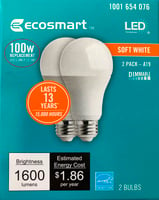
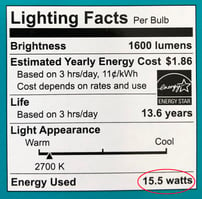
Lumens is the measure of the light bulb’s actual brightness, regardless of what color the light is. The higher the number, the brighter the light output will be.
If you are trying to choose between two bulbs, look at the packaging and see which one is brighter based on the lumens.
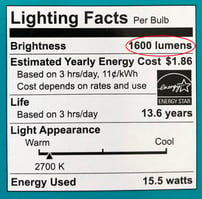
This is one of the most important pieces to understand. The color of the light bulb is what most people are concerned about—they don’t like a white light, they want a warm light, etc. Here is a color scale that shows you the range of light bulb colors.
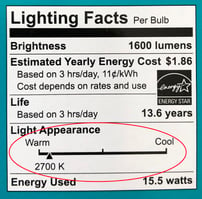

Most people use light bulbs that are in the 2700K-3000K color range for standard indoor light fixtures. These bulbs give off a more yellowish warm light.
4100K is often in a commercial setting, like offices. It is a more white light but not the whitest light you can get.
5000K is the most "white light" you can get. That color is typically used in automotive shops and other commercial settings where white light is beneficial. You can also use 5000K light bulbs at your house for outdoor lighting and in your garage. Also, if you are getting older and want to see a little better in your home, we have noticed a trend of people putting 5000K light bulbs in their bathrooms and living rooms so that they can see better with a whiter light.
6500K, on the far right-hand side of the color scale, is more of a blue light, and is used when people need to simulate natural light in an indoor setting. When choosing your color, think about how you want the light to look in your particular setting.
It's important not to choose a color based on the description on the box (daylight, soft light, warm light, etc.) because all manufacturers list their bulbs differently. Some daylight bulbs won't be the same hue as another company’s daylight bulbs. The only way to get the correct color is to look on the back of the box and see what it says about the color based on the color scale and choose that way.
If your light fixture is on a dimmer switch, or if you want to change it to be on a dimmer switch, you need to make sure you buy light bulbs that are dimmable. If you don’t buy the proper bulbs, it will damage the dimmer switch.
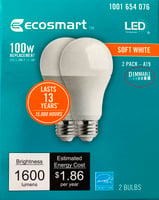
If your light fixture is totally enclosed or if it is a recessed fixture, you need to make sure the light bulb is rated to be in an enclosed or recessed fixture. Otherwise, you could create a fire hazard due to excess heat in the fixture.
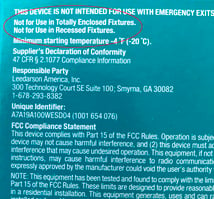
LED light bulb packaging will also give you an idea of how long the bulb will last based on a certain amount of usage.
Take a look at the example below—if the bulb is used for three hours each day, it will last for 13.6 years. If you use it for six hours a day, it will last for half that time. If you use it for just one hour per day, it will last three times as long.
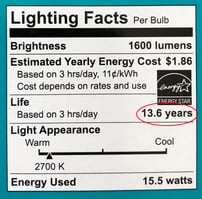
Are you looking to upgrade the lighting in your home? Are you remodeling your home and adding recessed can lighting or changing your light fixtures? Click below to contact us and we'd be happy to provide an estimate for your lighting project.